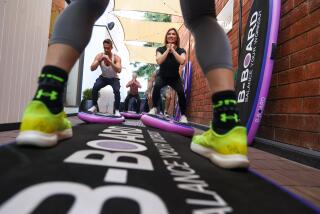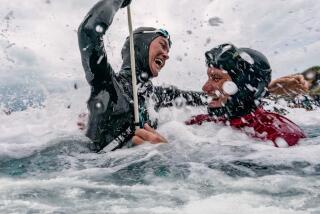Step, Step, Dip : Aerobics Classes Take the Plunge to Walk Under Water
- Share via
So you are a seasoned step aerobics aficionado and feel that you are on the cutting edge of fitness. Well, that step has taken a dive--underwater.
Step aerobics has taken on the wet look. For two years, Los Caballeros Racquet & Sports Club in Fountain Valley has offered an aqua-step class under the instruction of aerobics director Barbara Grant.
Grant sees water workouts as a cross-training option and as a way for people to get out of the gym and into the pool.
“Many of my students are baby boomers who take their exercise seriously and were taking five step classes a week. I became concerned about possible overuse injuries in the knees, calves, Achilles’ tendon, hips and spine,” said Grant, who is certified by the Aqua Exercise Assn., Aerobic and Fitness Assn. of America and American Council on Exercise.
These injuries occur from constant and repeated actions during sports or exercise.
“I challenged my regular land-step students to take a water-step class one day a week to see how their bodies would feel. I wanted to show people that you can get a good workout in the water and that it is a viable cross-training option,” Grant said.
Aqua step benefits cardiovascular fitness, muscle endurance, lowered body fat and increased muscle without the impact one endures on land, experts say. Step studies done by Drs. Lorna and Peter Francis at San Diego State University have shown the impact of stepping is equivalent to walking at 3 m.p.h. Performing aqua step uses even less impact.
Ruth Sova, founder of the AEA, explains in her book, “Aquatic Exercise,” that in land stepping you work against gravity and body weight, but when you step down gravity helps you.
In the water as you step up, you work against body weight, some gravity and water resistance, but as you step down, the body works against water resistance and buoyancy, Sova explains.
Grant emphasized that more muscles come into play in the water to stabilize and balance the body. And when an exercise isn’t painful or exhausting, perhaps even enjoyable, chances are a person will keep at it longer.
Others concur. “A person can keep up the intensity longer. With higher, more vigorous propulsion (explosive jumping action), you can work longer and not increase the risk of injury,” said aqua-step pioneer Sandra Nicht of the City Sports Squash & Racquet Club in Washington, D.C., who uses aqua step as a cross-training method.
Propulsion or explosive jumps are known as plyometrics. John Horsley, founder of RESTOR Sports Physical Therapy in Fountain Valley, uses plyometrics as part of his Aquakintic rehabilitation program. Horsley, who works with world-class athletes, is optimistic about using the step with constant resistance of the water.
“We could apply plyometrics for the advanced athlete, depending on the height of the step,” he said.
Whether jumping or walking, water exercise seems less taxing because the heart rate is automatically lower--the AEA says approximately 17 beats lower than during a land exercise.
The cardiovascular workout is comparable to a land workout, according to the Human Performance Lab at Adelphi University. It’s just that the body, including the heart, does not have to work so hard to cool off or to fight gravity.
Grant’s class starts with a warm up of water walking, stretching on and off the step as she guides her students from pre-aerobics into the full-scale workout.
Because her students are familiar with her as an instructor and familiar with step, Grant teaches mostly in the water. However, aqua step is not just for experienced land steppers or fitness buffs.
“I was originally teaching (people who had) arthritis, (were) overweight, (had) joint replacement (or other) clients whose only option was water exercise,” Nicht said.
“Those who were told to do land stepping found it too painful, so I tried aqua step. People who were too weak for land step improved their strength through water step,” she said.
Grant incorporates aqua step to introduce exercise to her out-of-shape and overweight clients. In one-on-one training sessions, Grant starts the student off slowly and carefully, she said.
And she discovered that the water provided another benefit to her novice exercisers. “They were all comfortable that they didn’t have to see their bodies from the waist down,” Grant said.
For safety and practicality, aqua steps should be made from dense plastic or fiberglass. Grant uses the brightly colored eight-inch Connie Williams Bench 2000 steps and increases stability by adding diving weights.
Other safety tips include being conscientious about posture, having a well-constructed swimsuit and protecting the feet by wearing aqua shoes or an old pair of sneakers, Grant said.
“Shoes should be worn to prevent slipping on the pool or step surface, help with balance and focus on correct landing,” she said.
And for those who lack coordination?
“You don’t have to worry about left and right so much in the water,” Grant said.
Aqua step lets a person get a tough but safe and refreshing workout. It’s a change of pace and place. Plus those used, high-tech sneakers that gave their all to indoor aerobics can now be recycled with a splash.


